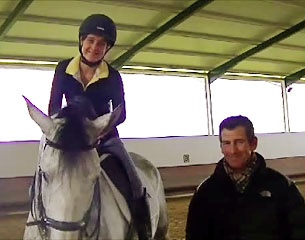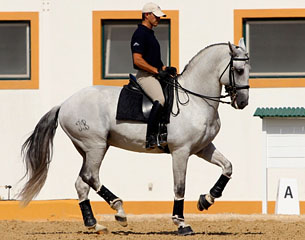
Excited just to get the invitation to a recent Richard White clinic in Portugal, I felt a little out of my league lining up with Miguel Ralao, Daniel Pinto and Goncalo Carvalho, three of Portugal's most experienced Grand Prix riders. Added to that was the fact it was my first time riding Batialo away from my own stable and I wondered whether his often over-enthusiastic personality might take over the 45 minute lesson.
So we arrived early and gave him a warm-up lunge and to my delight he was switched on from the minute he set foot onto the arena, aside from a few neighs -- after all he is a gentlemen -- he had to just say hello!
Richard advised me to start the warm-up and so I carried on my usual routine, walk loose rein, slowly begin trot on big circles in loose rein stretch and then gradually begin to incorporate transitions and smaller circles with bending. Once I had warmed-up the canter, Richard stepped back into the arena and after watching me for just 15 minutes, he had already pin-pointed all the majors weaknesses in my position.
When I told him that I had been injured from being hit by a car three years ago, he joked, “Oh good! Another disabled rider." I laughed, as I’m quite sure that every horse-rider comes with some sort of issue, be it mental or physical.
According to Richard, the sitting trot was my area of weakness and he was absolute correct. I have been struggling for a long time with trying to keep the swing, balance, and connection to Batialo's mouth in the sitting trot. I am able to get it in rising and I can feel his stretch forward with confidence into the bridle and engaging himself behind but the minute I sit, something stiffens in me which translates into him stiffening up and loosing the impulsion thus affecting the contact as well.
Having worked for many months on trying to get more weight down into my feet, I have been having trouble getting my legs more beneath me, trying to sit more over my pelvis and lower my thighs down under my body. However, Richard found that this put my legs around the widest part of my horse’s body and made it almost impossible for me to take my leg off to give the aid.
If you watch the top riders, they are able to lift their entire leg off the horse and Reiner Klimke used to actually release his legs every now and again to release the tension that had built up. Why can the riders do this? They have of course established a "deep seat". While that may be different for every rider, for me, I needed to sit further back in the saddle, lifting the angle under my knees and allowing my calf to come more towards his shoulders, where I could use them effectively. This then put me on the slightly more padded part of my bottom (I am not very big) where I could then feel as if I was sitting on his hind legs and suddenly, the horse was in front of me and not behind me.
When asked to then do a shoulder-in, instead of me scrunching up into a ball and getting stuck, I was able to simply steer the horse’s withers on a diagonal and use my calf muscle freely to tap him up the long side. I was amazed at how much difference this small adjustment had made and I was then able to apply the same principle in the canter. Shifting myself back in the saddle, I could use my legs just behind his shoulder to tap him and keep the momentum. My "deep seat" was engaging the hindquarters and allowing him the room to lift in front.
 Olympic rider Miguel Ralão hosted the clinic at Quinta dos Cedros and felt that, as he usually works alone, Richard’s tips and pointers or "fine-tunings" were just what he needed. "When you work by yourself you need someone to just remind you of the little things that you often do but aren't aware of by yourself," Ralao explained. "For example, I have a tendency to become a little hollow in the back and Richard has some great analogies to help us keep that in our mind so we can work on it all the time."
Olympic rider Miguel Ralão hosted the clinic at Quinta dos Cedros and felt that, as he usually works alone, Richard’s tips and pointers or "fine-tunings" were just what he needed. "When you work by yourself you need someone to just remind you of the little things that you often do but aren't aware of by yourself," Ralao explained. "For example, I have a tendency to become a little hollow in the back and Richard has some great analogies to help us keep that in our mind so we can work on it all the time."
Advising riders to imagine they are riding in pants that have pockets on the back, Richard tries to get you to feel as if you are sitting on those back pockets, thus enabling you to sit more on your seat bones, and not come forward and hollow your back.
With three horses involved in the two day clinic, Miguel believes that the best results are not achieved during the lessons but it is rather when you take home and repeat the little hints and ideas that Richard has given you, that you see the true progression. "With the younger horse, Califa, we worked on the balance, particularly in the canter," said Miguel. "He is just beginning to get more collection and lift and as we are beginning the flying changes I found that Richard's help to balance the canter on the circle made it more possible to ask the changes. Instead of asking then on the diagonal, we were told to ask them whenever we felt the balance was right and this helped the horse to understand and deliver."
His two more advanced horses, Zaire and Rico, worked more on the movements and Richard was able to help Miguel find the right buttons to push to get the best results. "With Zaire I was not getting the right aid for the one tempi’s but through the clinic I was able to fine-tune this and now I have the horse getting the 15 each time. Rico knows everything so with him I was working on the canter pirouette’s: making sure to maintain the bend and not change anything as we enter the pirouette."
Overall, Miguel says Richard's focus is right where it should be: on the basics. By working on the balance and the general quality of the gaits, you can take the lesson on-board as homework and continually use his advice to improve yourself and your horses.
Travelling to Cedros with two of his top horses, Portuguese rider Filipe Pinto Canelas wanted to improve the quality of his international partners. He brought along his Grand Prix horse Der Clou and his Lusitano small tour horse Air. "I chose these horses because with Der Clou I'm competing in international events and therefore, the help of Richard is important to improve the quality of my test presentation."
Air is a horse that Filipe believes has great potential for the future and Filipe knows that Richard can help a lot to improve the horse’s basics. "Richard's clinics aim to give each individual pair a unique set of instructions to help them overcome their problems and difficulties. Richard is up to date with the current mode of competition and has vast knowledge of how a horse should be presented in the arena," said Canelas.
Agreeing with Miguel, Filipe feels that working with Richard is the type of opportunity that only pays off in the long term so it is important that riders benefit from his teachings as frequently as possible. "In order to understand what he wants of you and why he wants the horse in a certain position riders must understand that we are in a partnership where the ultimate goal is the teaching of competitive dressage. Thus, we must go home and attempt to follow the advice so as to achieve consistency in our training and the evolution of the clinic advice. Overall, I find that Richard is more concerned with the quality of gaits and presentation than in simply performing the exercises for competition."
by Sarah Warne for Eurodressage
Related Links